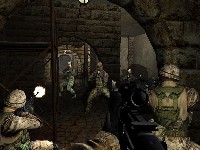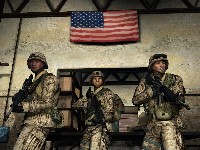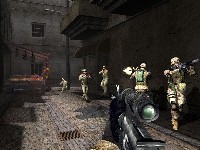Genre: Tactical FPS
Publisher: 2K Games
Developer: Atomic Games
Release Date: April 6, 2005
Buy 'CLOSE COMBAT: First to Fight': Xbox
Close Combat has been a long running series of top-down tactical wargames that has encapsulated small unit warfare to such a harrowing degree that no one else has ever been able to capture that same sort of intense gameplay. Four Close Combat games have been released to a faithful audience who loved the gameplay that centered around unit morale, cohesive fire orders, daring maneuver orders and keeping a coherent formation.
Today we have Destineer and 2K Games' Close Combat: First to Fight, a first person tactical shooter based around a Marine Corps Fireteam, a complete and total departure from the original formula which made earlier Close Combat incredibly fun, challenging and fulfilling tactical scenarios. Change is good. It is always a positive thing to see a developer go outside the known formula and evolve the genre or the franchise. One can easily see that the transition from top-down tactical maps to first-person corridors and issuing dynamic orders to individuals rather than squads has been a rough one.
To understand First to Fight, you need to understand what the game is aiming to achieve which may not be obvious. You will constantly hear in the media how America boasts the world's best military and without a geopolitical lecture on foreign policy applications and the strategic means of implementing these policies, let us assume that the former statement is true. The reason why the American military machine is so effective at war-fighting is not because of technology but rather, and excuse me if this sounds trite, simple teamwork. No one else can integrate assets, personnel and skill sets better than the American military. Whether it is the Navy, (ch)Air Force, Army or Marines, the American Land Battle Doctrine focuses on fighting in width and breadth.
Now, with this in mind, First to Fight is trying to take a magnifying glass and zoom in on the smallest cog in this vast machine, a cog that if it didn't turn correctly, would lead to the breakdown of the entire machine. That little cog is the fireteam. First to Fight is all about implementing the organic firepower of this one little team of five men in conjunction with indirect fires from artillery, direct fires from close air support assets and supporting fires from sniper/scout teams that can also provide further intelligence on the immediate area. This little dance of destruction perfectly creates a microcosm of how the American military works. Now, the question remains: How well did Destineer and 2K Games create this little microcosm?
First to Fight's greatest strength is its adherence to authenticity and accuracy. Your fireteam will only have what a real fireteam would have; the rifles are accurate down to the ACOG reflex sights mounted on the receiver rails. The Marines wear the new style camouflage and carry authentic-looking, load-bearing equipment. The models move realistically and carry their rifles appropriately when moving or when sighting downrange. Some of your Marines tuck their pants into their boots while others let their pants fall naturally around their ankles. To that end, the boots are textured and modeled to resemble the actual Marine Corps Leather Personnel Carrier.
The only inaccuracy, and this can been argued, is that you are given a team of four men. You should have command over six men if you're a fireteam leader, as a Marine Corps squad consists of thirteen men and that breaks down into two fireteams of six each with the squad leader heading up one of the teams. It's a concession that is a practical one and could be argued simply that there has been attrition among your platoon. In any event, your abbreviated fireteam looks, acts, sounds and maneuvers in a way resembling that of a real Marine fireteam.
Where First to Fight begins to falter is in its gameplay mechanics. First to Fight is all about small unit tactics in an urban environment, and all of the missions take place in congested city streets or corridors. You control your Marine much like any other first person shooter; you can aim down your rifle's sights, and your ballistics are affected by movement. Your reloading time and actions are consistent with the real thing, and there is some noticeable "head-bob" when you run. Your fireteam reacts but reacts rather poorly. You have to guide your men into position and give them orders to move and fire as any team leader should.
My problem came in the implementation of these commands and the awkwardness of delivering them. There are several sub-menus to navigate in order to give a series of commands which are nuanced, but really many of these commands should not have to be given. For instance, if you are moving in a tactical column down a street, your SAW gunner who is bringing up the rear (which he shouldn't because your SAW gunner should second or third in your column) shouldn't have to be told to cover your aft. He's supposed to be covering that arc on his own. I also don't see why you should have to tell your team to stack up outside a door then be told to frag and clear that door. If you order your team to clear a room with or without a frag, they should stack up on the door then execute the command on the go order.
What I am getting at is that if First to Fight is supposed to be a recreation of tactical warfare in an urban setting, it cannot afford to be bogged down in a methodology of gameplay. Even if you do learn the commands and become proficient at their employment, First to Fight is still slow. Despite its inefficient gameplay, First to Fight certainly is methodical in nature and requires some forethought, which is something most FPS games inherently lack.
Something First to Fight certainly lacks is AI. Close Combat boasted a robust system of morale which was affected by performance, given orders and proximity to friendly units. The same idea is supposed to be transferred to your mates in First to Fight, but I cannot say that I see the same effects here. My teammates, sad or happy, scared or delighted, trudged along and killed or got killed at about the same rate. Every once in a while, when things really got sideways a guy would refuse an order, but that was hardly evincing. Whenever that happened, I ended up starting over anyway.
Sadly, First to Fight's issues do not end there. To put it simply, this game is buggy. I had a really bad feeling when the opening videos ran at ten frames a second with stuttering audio and Destineer's recommended fix was the deletion of the videos from the file folders. With moderate graphic features turned on, this game chugged at times during single-player missions and would flat croak during multiplayer. Clipping is rough in many places where bad guys hide behind corners and are able to shoot through hardened surfaces when they shouldn't be able to, and there's an annoying bug in multiplayer that effectively doesn't allow you to reload.
All in all, First to Fight is a rough outing. While I would not label First to Fight as a bad game, I would say that First to Fight is a good concept and core set of design ideas that have been poorly implemented. Personally, I would have rather not seen the Close Combat franchise go this route, and I hope that Destineer and 2K Games return to the game's original concept because as it is, Close Combat was the only game of its kind. What we are left with now is a tactical FPS that fails to distinguish itself from other games in the genre. Sure, the game looks beautiful and with some patches, the gameplay issues, glitches and sound bugs can be fixed to make First to Fight into a decent game.
There is currently small but dedicated community who is keeping the game alive over the internet, and I'm sure mods are already available or be made available soon, as the game's engine is based off of the Unreal Warfare engine. Even so, I am disappointed in this game. I love military-themed games, I find them fascinating and intriguing, especially ones that really engage with the tactical nuances of modern warfare. First to Fight looks in the right directions but simply doesn't go there. Perhaps if First to Fight is the first of a series, then future iterations will see improved mechanics and a more nuanced gameplay scheme that would distinguish First to Fight, which is, after all, a severe departure for the game. Even so, I'm crossing my fingers that Close Combat returns to what it was rather than continue with what it is.
Score: 6.5/10
More articles about Close Combat: First To Fight











 Lead a four-man fireteam of US Marines through the perils of authentic, modern urban combat in a Middle-Eastern urban battleground. This is an action-oriented, first-person 3D shooter that is being developed under the direction of the US Marine Corps as a training simulation for use by the Marine Corps. Close Combat: First to Fight is as close as you can get on a computer or Xbox to being a Marine fireteam leader in modern urban combat!
Lead a four-man fireteam of US Marines through the perils of authentic, modern urban combat in a Middle-Eastern urban battleground. This is an action-oriented, first-person 3D shooter that is being developed under the direction of the US Marine Corps as a training simulation for use by the Marine Corps. Close Combat: First to Fight is as close as you can get on a computer or Xbox to being a Marine fireteam leader in modern urban combat!









































